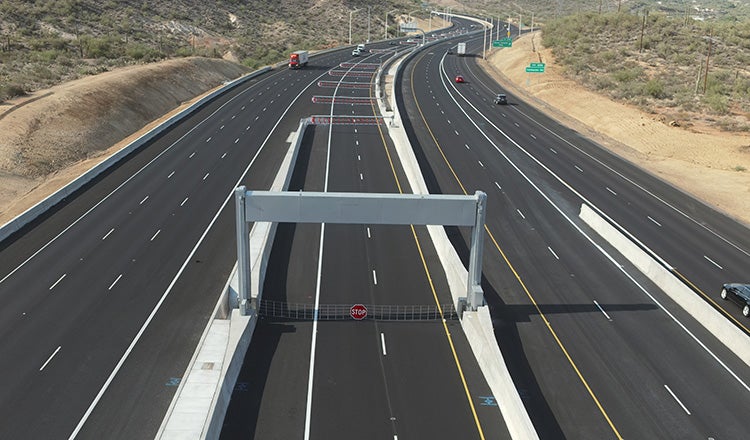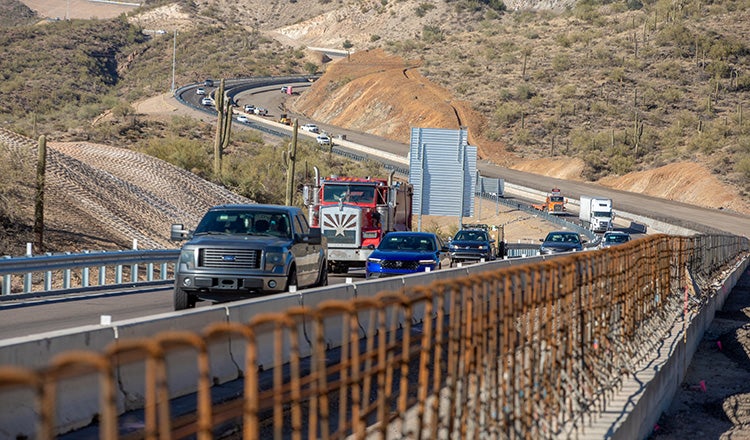I-17 Flex Lanes

I-17 Flex Lanes
First-of-Their-Kind Lanes in Arizona Improve Safety and Capacity in Busy Phoenix Area
- 8 miles of flex lanes to improve reliability and transportation options
- Delivered through a design-build-operate-maintain method that accelerated the project
- Reduced construction closures to limit impacts on travelers
One of Arizona's most heavily traveled roadways, Interstate 17 runs from Phoenix to Flagstaff and on to the Grand Canyon. The interstate is the only route connecting the Phoenix metro to northern Arizona. Heavy traffic volumes, especially during weekends and holidays, have led to congestion and delays, particularly when vehicle accidents occur.
The I-17 Flex Lanes project expanded 15 miles of interstate from four to six lanes, and added 8 miles of flex lanes north of the Phoenix metro area. The project also widened 10 bridges, replaced two others and includes three years of operations and maintenance of the flex lanes. The long-awaited improvement project adds capacity, reduces congestion and improves safety.
ADOT submitted an Infrastructure for Rebuilding America (INFRA) Grant application in March 2019, which was prepared by HDR, and was awarded $90 million which allowed ADOT to construct the southbound widening of I-17 and the flex lanes. Additional funding sources included federal, state highway funds, and Maricopa Association of Government funds for a total project budget of $544 million.
HDR provided general engineering consultant services to the Arizona Department of Transportation (ADOT) on the project from its beginning in 2020. One of our first tasks was a cost, schedule and risk workshop that explored multiple procurement and project delivery scenarios to determine cost effectiveness, including a value for money analysis. Following the workshop, ADOT chose a single design-build-operate-maintain (DBOM) method to accelerate the project’s design and construction.
Our team led the procurement phase, involving industry outreach, development of an RFQ, shortlisting of qualified proposers, development of an RFP and evaluation of proposals. Throughout design and construction, our team provided contract administration, project controls, program management, and design and construction oversight support. Our strategic communications professionals have also served as an extension of ADOT staff, using outreach and visual storytelling to educate and engage the public, providing progress updates and celebrating milestones that highlighted the daily construction process.
A Flexible Transportation Solution

As the first flex lanes in Arizona, the unique roadway allows both north and southbound travelers to use the lanes, depending on the greatest need. Constructed next to the existing southbound general-purpose lanes and separated by a concrete median barrier, the flex lanes will be open northbound from Monday through Saturday, then southbound on Sundays. However, they can flex — as the name suggests — to whichever direction has the heaviest traffic to accommodate holidays, special events and incidents, letting motorists move more efficiently. Overhead signs alert drivers to which direction the flex lanes are traveling.
The two-lane entrances to the flex lanes feature a series of swing gates and a net barrier, preventing cars from traveling in the wrong direction. Four sets of steel median barrier gates, located throughout the flex lanes, can be opened to make way for emergency vehicles and to clear traffic out of the flex lanes when incidents occur. The entire flex lane system is managed, monitored and controlled remotely by ADOT’s traffic operations center with cameras throughout the corridor.
Limited Construction Closures

Despite major construction activity throughout this heavily traveled corridor, I-17 remained open. Weekend lane closures were not permitted, and lane closures were limited to nights only during the week, which reduced impacts to travelers relying on the corridor.
Blasting through the mountains was one of the biggest challenges.For safety purposes, full closures of the interstate were required for the 70 nights of blasting. To minimize traffic impacts, blasting closures were only permitted for one hour after 10 p.m. during the week. Crews had just one hour to close the highway, carry out the blasting operation, clear the debris, and then reopen the highway.
The construction team reincorporated approximately 185,000 cubic yards of rock and material that was removed from the blasting operations into the new roadway. A large portion of the blasted material was crushed and used as aggregate base, embankment and rock mulch along the project limits. This reduced construction costs and eliminated the need to outsource material.
Another project challenge was widening the freeway over existing reinforced concrete box culverts, which were originally constructed with reduced sections towards the ends as the embankment heights decrease. There were several locations where the reduced sections of the existing box culverts did not have the structural capacity to accommodate the additional embankment loading. The engineered solution was to utilize lightweight foam glass aggregate material as fill over these sections of box culverts. The dry unit weight of the foam glass aggregate is only 12-19 pounds per cubic foot with a compressive strength of 15 kips per square foot. This was the optimum solution with the least impact on construction and the least cost of the alternatives evaluated.
In addition to the 8 miles of flex lanes, 15 miles of roadway widening, and widening of 10 bridges, and replacement of 2 others, the project included over 200 culverts, roughly 2 million cubic yards of material that was excavated, 360,000 cubic yards of asphalt paving, 47,000 tons of asphaltic rubber friction course pavement, and 14,000 tons of foamed glass material that was placed over concrete box culverts.








